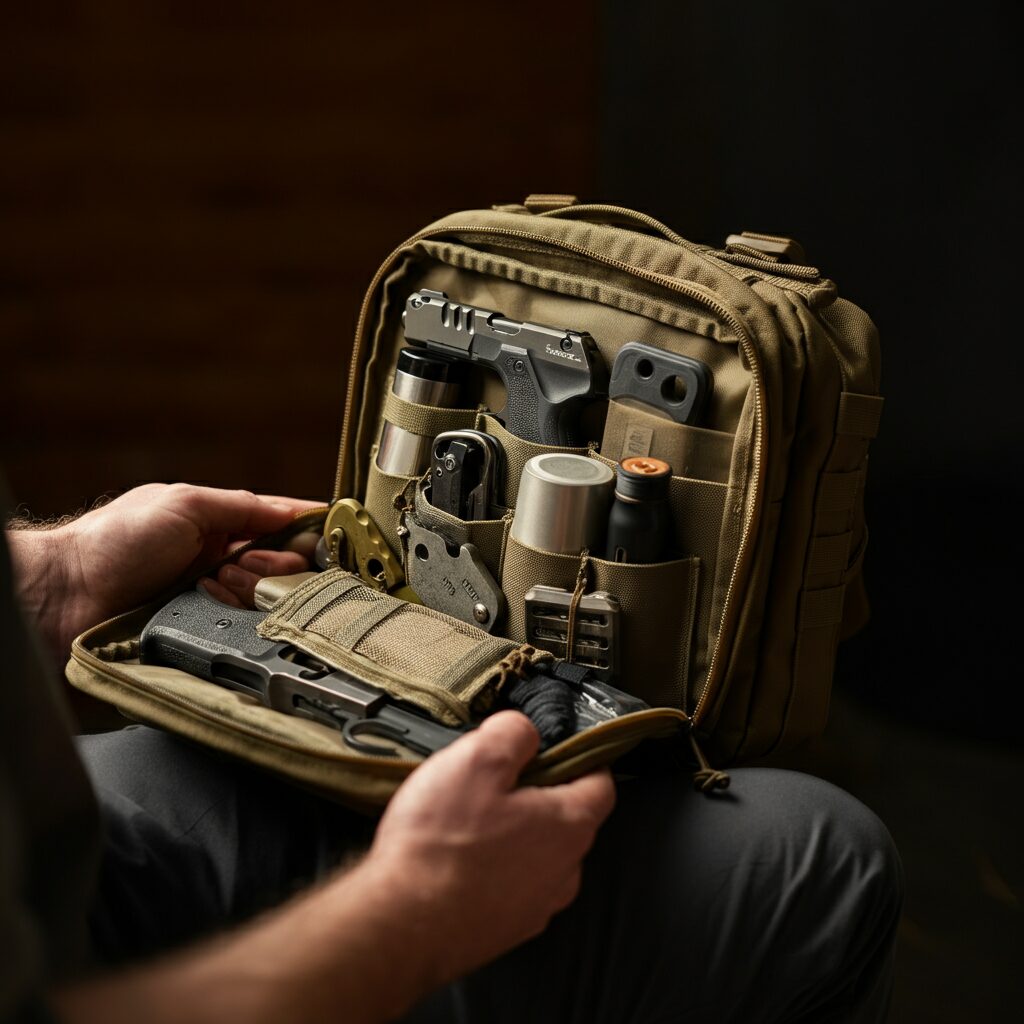Disclaimer: Although we base all of our reviews on both our product testing and that of other customer reviews. That being said, this website contains affiliate links for products we talk about. You don’t pay any more for any products you purchase by clicking on links but we might receive a small commission for our recommendation to those products we link to.
Whether you’re heading to a grocery store or spending the day exploring your city, having an EDC bag (Every Day Carry) ensures you’re prepared for life’s little emergencies.
But some items in your bag might inadvertently cause unwanted attention, especially if you’re stopped by security at a store.
Have you taken a closer look at what’s in your EDC lately? Here’s how to avoid turning your essential items into triggers for suspicion.
Can Store Employees Legally Search Your Bags?
This is a gray area that’s often misunderstood. Legally, shop employees in most states have the right to ask to check the contents of your bag if they have reasonable suspicion of shoplifting. However:
- They’re not allowed to touch items inside your bag.
- If asked, you can move the contents to provide clear visibility.
- Declining to show your bag may result in them detaining you until law enforcement arrives.
According to Legalvision, if a store has reason to believe you’ve shoplifted, employees do have a right to detain you.
That said, they are required to maintain reasonable conduct until the police arrive.
Be mindful of your rights but stay cooperative to avoid unnecessary tensions.
What Happens If Your EDC Bag Is Searched?
Now, imagine you’ve been asked to open your bag. Security is watching you closely, and you oblige, lifting the lid of your carefully curated EDC.
Inside, they see an opened bottle of hand sanitizer, Altoids, and a needle and thread kit. Regardless of whether you purchased them from a different store last month, these items might trigger suspicion.
Even innocuous everyday items like tissues or snacks can raise questions, particularly if they resemble store-sold products. This is why it’s essential to carefully organize and prepare the contents of your EDC to minimize misunderstandings.
Practical Tips to Avoid Suspicion
1. Break Down Items
Remove packaging to ensure your items look like they belong in your bag—not just purchased.
- Remove price tags, cellophane wraps, or store-branded packages.
- Repurpose carrying methods; for example, empty tissues from their store wrapping into cloth handkerchiefs or small reusable pouches.
- For small medications or painkillers, take the contents out of store packaging and place them in containers like Altoids tins for a more worn, personalized touch.
2. Add Personal Touches
Make it clear your items are for personal use by adding custom elements.
- Wrap over-the-counter medicine bottles with black tape or paracord.
- Place hand sanitizer and small snacks into labeled or reusable Ziploc bags.
- Add extra features like rubber bands, string, or duct tape to packaged contents to make them look “prepped” for practicality rather than theft.
3. Engrave or Personalize Durable Goods
For durable items such as knives, multi-tools, or flashlights, engraving them with initials or marking them with permanent markers makes it clear they’re personally owned.
Pro tip: Cover your markings with a strip of clear adhesive tape to prevent fading over time.
4. Pack in Layers
Strategic organization helps avoid red flags.
- Place transparent or frequently needed items in visible areas of your bag.
- Pack bulky items like water at the base, ensuring items like flashlights or small pouches are easily accessible on top.
Addressing Tricky Items
Snacks and Treats
Many snacks like individually wrapped crackers, peanuts, or jerky could trigger suspicion if sold individually in stores.
Instead, consolidate your snacks with small bulk items into clear bags, or mix in personal candies like mints to indicate intentional packing.
Water Bottles
Bottled water is a common point of confusion since it’s sold nearly everywhere. Consider alternatives such as reusable filtration bottles or collapsible pouches.
They’re not only less likely to cause suspicion but also environmentally friendly.
Tactical Tools and Knives
Any tactical tools included in your EDC should follow local regulations:
- Knives should align with concealed carry laws in your state (e.g., length limits, legality of switchblades). If legal to carry, show visible wear and usage to confirm they’re not store-bought items. You may also want to retain physical receipts in a separate, labeled compartment within your bag.
- Multi-tools or flashlights with clear markings or visible clips make it obvious they are yours.
FAQs
1. Can I refuse a search if approached by store security?
Yes, you can refuse, but security may escalate the situation by involving law enforcement if they believe you have stolen items. Cooperating politely reduces complications.
2. How can I differentiate my items from store merchandise?
Remove visible packaging, add personal customization, and pack items visibly “worn” or in use. Receipts for questionable items can also be handy.
3. Are there laws about carrying knives or firearms in my EDC?
Yes, laws vary significantly by state. Concealed carry permits and blade length restrictions often dictate whether you can include these tools. Research your local and state regulations to ensure compliance.
4. What are the consequences if my bag appears suspicious?
At worst, wrongful detainment leading to police involvement. While it’s unusual, documenting items with receipts or engravings can defuse tense situations. Remaining calm and cooperative is critical.
Time to Reflect on Your EDC Habits
Maintaining a practical yet inconspicuous EDC is an art form, especially in environments where bag-checks are common.
By proactively personalizing your kit, packing efficiently, and understanding legal nuances, you can prevent unnecessary scrutiny and continue enjoying the peace of mind a well-prepped bag brings.
Do you have personal tips or stories about organizing an EDC to avoid suspicion? Share them in the comments below!


0 responses to “What NOT to Carry in Your EDC Bag If You Want to Avoid Suspicion”